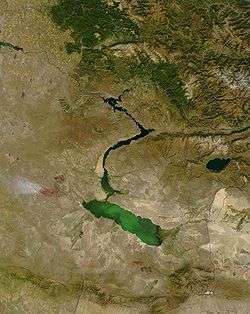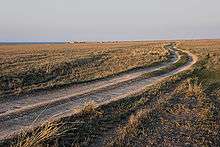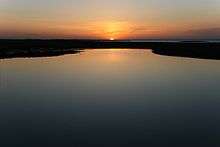Lake Zaysan
Lake Zaysan (Kazakh: Зайсан көлі, Zaısan kóli, زايسان كؤلئ, Kazakh pronunciation: [zɑjˈsɑn kɵˈlɪ]; Mongolian: Зайсан нуур, Zaisan nuur, en: Noble lake; Russian: Озеро Зайсан, Ozero Zajsan; simplified Chinese: 斋桑泊; traditional Chinese: 齋桑泊; pinyin: Zhāisāng Pō, Xiao'erjing: جَىْصْا پْ; Dungan: Җэсонпә) is a freshwater lake, ca. 1,810 km² (700 mi²), in eastern Kazakhstan, in a hollow between the Altai and the Tarbagatai Mountains. It is the largest lake in the East Kazakhstan Region.
| Lake Zaysan | |
|---|---|
 | |
 Lake Zaysan | |
| Coordinates | 48°00′N 84°00′E |
| Lake type | Ancient lake |
| Native name | Зайсан көлі |
| Primary inflows | Kara-Irtysh (Black Irtysh), Kendyrlyk |
| Primary outflows | Irtysh River (White Irtysh) |
| Basin countries | Kazakhstan |
| Max. length | 105 km (65 mi) |
| Max. width | 48 km (30 mi) |
| Surface area | 1,810 km2 (700 sq mi) |
| Max. depth | 15 m (49 ft) |
| Surface elevation | 420 m (1,380 ft) |
The lake lies at an altitude of 420 m, is 105 km long and 22–48 km wide, with a maximum depth of 15 m. Its major tributaries are the Kara Irtysh (Black Irtysh) and Kendyrlyk from the east; its only outlet is the Irtysh River (or White Irtysh). The lake is generally frozen from the beginning of November to the end of April, but still has an abundance of fish. Since the construction of the Bukhtarma dam on the Irtysh downstream from the Zaysan, the lake has risen 6 m (20 ft) above its natural level. As the result, the area of lake essentially increased (nearly doubled: from about 1,800 km² to 3,500 km²,[1] or even to 5,000 km²),[2] thus, in some sources the lake is indicated as part of an artificial reservoir.[3]
Lake Baikal is often considered the most ancient lake in the world, as clear evidence shows that it is 25–30 million years old.[4][5] Lake Zaysan, however, may be even older, dating possibly from the Cretaceous period with a likely age in excess of 65 million years old[6] (most probably around 70 million years[7]), although its exact age is controversial and labelled with some uncertainty.[8]A direct indication of the Lake Zaysan's age is hard to find, although some geological studies of the Zaysan Basin have been reviewed.[9] Artificial reservoirs cover large surrounding areas. Modern geological analysis of the entire field, apparently, supports an exceptionally old age for Lake Zaysan.[10][11]
History


The first Russian to reach the area was Ivan Bukholts who ascended the Irtysh to build a fort and search for gold. In 1715 he was driven back downriver by the Oirats, who had established the Zunghar Khanate in the region.
The Chinese Qing Empire conquered the Zunghar state in the 1750s. This prompted an increase in the Russian authorities' attention to their borderland; in 1756, the Orenburg Governor Ivan Neplyuyev even proposed the annexation of the Lake Zaysan region, but this project was forestalled by Chinese successes.[12] Concerns were raised in Russia (1759) about the (theoretical) possibility of a Chinese fleet sailing from Lake Zaysan down the Irtysh and into Western Siberia. A Russian expedition visited Lake Zaysan in 1764, and concluded that such a riverine invasion would not be likely. Nonetheless, a chain of Russian pickets was established on the Bukhtarma River, north of Lake Zaysan.[13] Thus the border between the two empires in the Irtysh basin became roughly delineated, with a (sparse) chain of guard posts on both sides.
The situation on the Zaysan in the mid-19th century is described in a report by A.Abramof (1865). Even though the Zaysan region was recognized by both parties as part of the Qing Empire, it had been annually used by fishing expeditions sent by the Siberian Cossack Host. These summer expeditions started in 1803, and in 1822-25 their range was expanded through the entire Lake Zaysan and to the mouth of the Black Irtysh. Through the mid-19th century, the Qing presence on the upper Irtysh was mostly limited to the annual visit of the Qing amban from Chuguchak to one of the Cossacks' fishing stations (Batavski Piket).[14]
The border between the Russian and the Qing empires in the Irtysh basin was established along the line fairly similar to China's modern border with Russia and Kazakhstan by the Convention of Peking of 1860.[15] The actual border line pursuant to the convention was drawn by the Protocol of Chuguchak (1864), leaving Lake Zaysan on the Russian side.[16][17] The Qing Empire's military presence in the Irtysh basin crumbled during the Dungan revolt (1862–77). After the fall of the rebellion and the reconquest of Xinjiang by Zuo Zongtang, the border between the Russian and the Qing empires in the Irtysh basin was further slightly readjusted, in Russia's favor, by the Treaty of Saint Petersburg (1881).
Footnotes
- Soviet Encyclopedic Dictionary, Moscow, 1980, p. 451.
- Soviet Encyclopedic Dictionary, Moscow, 1980, p. 451.
- "Lake Baikal – UNESCO World Heritage Centre". Retrieved 8 March 2018.
- "Lake Baikal: Protection of a unique ecosystem". ScienceDaily. 26 July 2017. Retrieved 8 March 2018.
- Lucas; Bray; Emry; Hirsch (2012). "Dinosaur eggshell and Cretaceous-Paleogene Boundary in the Zaysan Basin, eastern Kazakstan". Journal of Stratigraphy. 36 (2): 1376–1382. doi:10.1016/j.proenv.2011.09.220.
- Dorfman, B.F. (2011). "Zaysan-the Only Surviving Cretaceous Lake-May be Lost". Procedia Environmental Sciences. 10 (B): 1376–1382. doi:10.1016/j.proenv.2011.09.220.
- "The Oldest Lakes in the World". World Atlas. Retrieved 8 March 2018.
- AAPG Studies in Geology #46, (2000). Chapter 29
- L. E. Popov et al (2009)
- Kröner et al
- Abramof 1865, p. 65
- Abramof 1865, p. 66
- Abramof 1865, pp. 62–63; see also the border shown on the map before p. 65.
- Articles 2 and 3 in the Russian text of the treaty
- (See the map)
- The Lost Frontier: the treaty maps that changed Qing's northwestern boundaries
References
- Abramof, A. (1865), translated by John Michell, "The lake Nor-Zaysan and its neighborhood", Journal of the Royal Geographical Society of London, J. Murray, 35: 58–69, doi:10.2307/3698078, JSTOR 3698078
- AAPG Studies in Geology #46, Chapter 29: "Upper Cretaceous-Cenozoic Lacustrine Deposits of the Zaysan Basin, Eastern Kazakhstan." Spencer G. Lucas, Robert J. Emry, Viacheslav Chkhikvadze, Bolat Bayshashov, Lyubov A. Tyutkova, Pyruza A. Tleuberdina, Ayzhan Zhamangara. AAPG Special Volumes. Volume Lake Basins Through Space and Time, Pages 335 - 340 (2000)
- L. E. Popov, Michael G. Bassett, V. G. Zhemchuzhnikov, L. E. Holmer and I. A. Klishevich, "Gondwanan faunal signatures from Early Palaeozoic terranes of Kazakhstan and Central Asia: evidence and tectonic implications." Geological Society, London, Special Publications 2009, 325:23-64
- A. Kröner, B.F. Windley, G. Badarch, O. Tomurtogoo, E. Hegner, B.M. Jahn, S. Gruschka, E.V. Khain, A. Demoux, and M.T.D. Wingate, "Accretionary growth and crust formation in the Central Asian Orogenic Belt and comparison with the Arabian-Nubian shield, Memoirs."